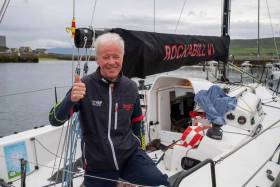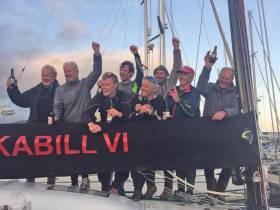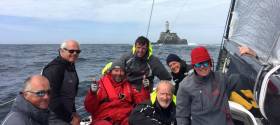Displaying items by tag: Paul O'Higgins
While sailing in Ireland has its conspicuously attention-getting aspects, the real backbone of the sport continues to be the active club sailor who can quietly keep a usefully large crew panel together in order to have the right mix of talents when taking on any special challenge.
Paul O’Higgins of the RIYC in Dun Laoghaire with the JPK 10.80 Rockabill VI is an excellent example of these quiet enthusiasts, these people who truly enjoy their sport, and his healthy approach was underlined during 2023 when – among other successes – Rockabill VI won the Irish Sea Offshore Racing Association Championship 2023 in a cliffhanger conclusion with success in the final race.
Paul O'Higgins is Sailor of the Month (Offshore) for September
One of the many "little miracles" which kept Irish sailing alive and active during the continually-changing official restrictions in the summer of 2020 was the flexible and effective administration of the Irish side of the Irish Sea Offshore Racing Association's annual programme by ISORA Chairman Peter Ryan of the National YC.
But in order to succeed in this, he needed the support of the skippers and crews who enjoy what ISORA has on offer, yet in a normal year would be able to plan their programme well in advance.
This wasn't possible in 2020, but thanks to a generous spirit among those involved, the Irish boats in ISORA had a very good season in the circumstances. Once again it came down to the outcome of the last race in September, and once again the final race overall winner, and new 2020 champion, was Paul O'Higgins (Royal Irish YC) with the JPK 10.80 Rockabill VI.
Winners Crowned in Online Irish Sailing Awards Ceremony
Royal Irish Yacht Club skipper Paul O’Higgins has won the Irish Sailing and Afloat.ie Sailor of the Year Award for his outstanding cruiser-racer season at an online awards ceremony tonight.
Dublin Bay skipper O’Higgins was the first double-winner of the Volvo Dun Laoghaire to Dingle race. Racing his JPK 1080 “Rockabill VI”, he also showed consistent form with a series of wins throughout the year, including a class victory at the ICRA National Championships in June, Calves Week in August, and the ISORA title in September.
Read a full profile of the winner and his record-breaking season by W M Nixon here
Eve McMahon of Howth Yacht Club, a trialist for the Tokyo 2020 Olympics, was awarded the Youth Sailor of the Year for her performance internationally in the Laser Radial class.
The Irish Sailing President’s Award was given to Gary MacMahon of the Ilen project from Limerick and West Cork. Gary spearheaded the project to repatriate and restore the historic wooden ketch, which is now used for community-based sailing and educational projects.
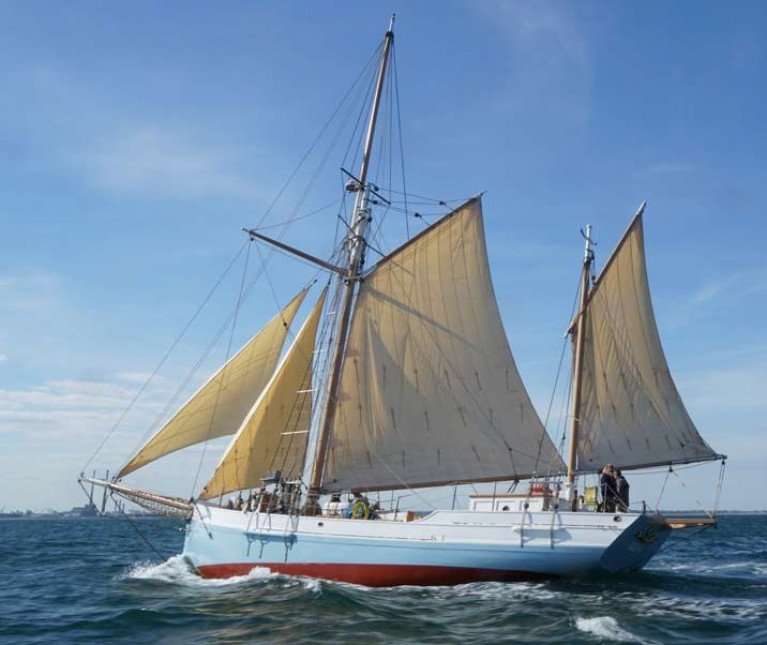 The ketch Ilen
The ketch Ilen
The Sustainability Award was won by two clubs – Bray Sailing Club (Co. Wicklow) and the National Yacht Club in Dun Laoghaire for their environmental work. The Inclusion Award was won by Jon Hynes and his team at Kinsale Outdoor Education Centre.
The Irish Sailing Senior Instructor of the Year Award went to Sam Hennessy of Wicklow Sailing Club.
Malahide Yacht Club took home the popular Irish Sailing Training Centre of the Year award, having been nominated as winners of the Eastern Region. The two other nominees were Galway Bay Sailing Club (West Region winners) and the Oysterhaven Centre (winner of the South Region).
The Irish Sailing Awards are supported by Dun Laoghaire-Rathdown County Council.
In line with social distancing measures in force for the COVID-19 emergency, Irish Sailing announced the winners online.
Paul O’Higgins is June’s Sailor of the Month (Offshore)
Defending the title with the same boat in the biennial 270-mile Volvo Dun Laoghaire to Dingle Race is a real challenge at a time when the cruiser-racer fleet is expanding with some very hot new designs. But Paul O’Higgins (Royal Irish YC), with his well-tested JPK 1080 Rockabill VI, proved up to the challenge by becoming the first skipper to win two in a row in a race which demonstrated the need to be able to maintain top performance right to the end.
More on O'Higgins' stand out 2019 season here
Paul O’Higgins (RIYC) is November’s Afloat.ie “Sailor of the Month (Offshore)” for the sporting way he campaigns his JPK 10.80 Rockabill VI.
He knew when to make it serious to win the Volvo Dun Laoghaire to Dingle Race, but equally he won his class in Calves Week as part of a family holiday.
And he gallantly campaigns the DBSC Turkey Shoot as a front runner on the water, but carrying a stratospheric handicap.
The 275-mile Volvo Dun Laoghaire to Dingle Race overall win was still open to challenge until the leader on the water, Paul O’Higgins’ JPK 10.80 Rockabill VI, had cleared the Fastnet Rock. However, with every mile sailed thereafter, it looked increasingly likely that Rockabill was on track to win every title for which she was eligible. Only a total catastrophic failure of boat or equipment was going to prevent it. But there was no failure of any kind. The JPK 10.80 comes at a significant price premium because this is a clearly defined concept which just doesn’t do boat or equipment failures. W M Nixon tries to pin down why the Dingle win seemed so special.
Success has many fathers, while failure is an orphan. As Paul O’Higgins’ JPK 10.80 Rockabill VI has increasingly found her form in Irish sailing since arriving new from the builders just over a year ago, there’s no lack of people ready to tell you how and why they counselled him to go for an expensive new JPK 10.80, rather than a reasonably-priced second-hand J/109 like so many others.
But as one of Dublin’s leading barristers, Paul O’Higgins is his own man, quiet in demeanor yet thinking on his feet at the speed of lightning, while effortlessly storing any new information in a well-furnished brain. His approach to sourcing a new boat as the 2014 season drew to a close was forensic in its analysis, and the way he picked on a JPK 10.80 before they’d hit the headlines of major success is illustrative of how he functions.
Not being a cradle sailor, he can look at boats in a coldly dispassionate way. He hadn’t sailed at all until he met his future wife Finola Flanagan at College, and as the Flanagans of Skerries were the total sailing family, he soon found himself roped into sailing with his future father-in-law Jack Flanagan on a series of boats all named Rockabill after that distinctive lighthouse-topped rocky islet that is eight miles east of Skerries out in the Irish Sea, an islet big enough to provide a home for Europe’s largest colony of the rare roseate terns.
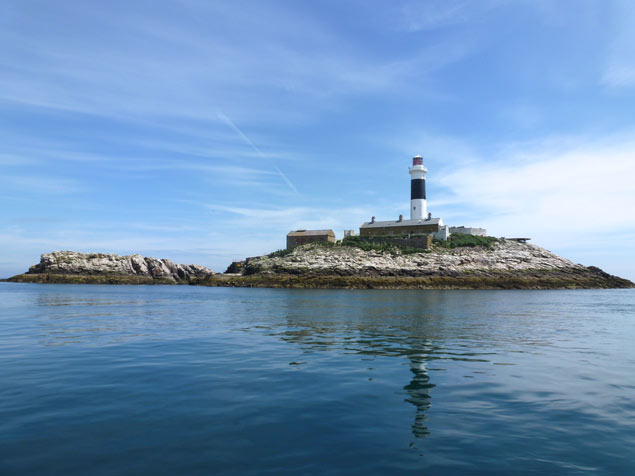 The one and only original Rockabill is still a couple of hundred miles from the Fastnet Rock. Photo: W M Nixon
The one and only original Rockabill is still a couple of hundred miles from the Fastnet Rock. Photo: W M Nixon
From being a visitor who might pull a rope when asked, the daughter’s suitor developed into a crewman, and as his taste for this weird but wonderful sport grew, he became a partner in the continuing succession of Rockabills, going into co-ownership with Jack in a souped-up First 30, Rockabill II.
By 1998, the balance was changing naturally with the passage of time, and Paul was becoming the pace-setter when they moved into a First 33.7 Rockabill III. He was competitive, yet no more naturally able at sport than most. An enthusiasm for playing rugby had been brought to an end by a knee injury, but he can still give a reasonable account of himself on a tennis court. However, it was the hugely complex wind-driven vehicle sport of campaigning a cruiser-racer under fair handicap rules which increasingly appealed to him. Having made the happy discovery that he seemed to be immune to seasickness, he stepped up his level of involvement.
His father-in-law had long since become eligible for the free travel pass, so the stage was reached where Paul bought him out while still with the First 33.7, and then with the turn of the millennium he was thinking of another boat slightly further up the Beneteau range, the highly-regarded First 36.7, and with her he achieved his first significant win in an IRC event.
Professional and family life were at their most demanding, yet somehow he found the time to campaign the First 36.7 Rockabill IV in several significant series and regattas, building up both experience and skills, while at the same time enlarging his circle of like-minded friends to create the kind of crew panel – more than twice the number of actual crew on the day - which is necessary to campaign a serious boat at this level.
With every year, however, the level became ever more demanding, and in admitting to himself that the First 36.7 was no longer cutting the mustard at the heights to which he aspired, he reckoned by 2008 that he needed to be in a Corby, and a new Corby 33 was what he could most comfortably afford.
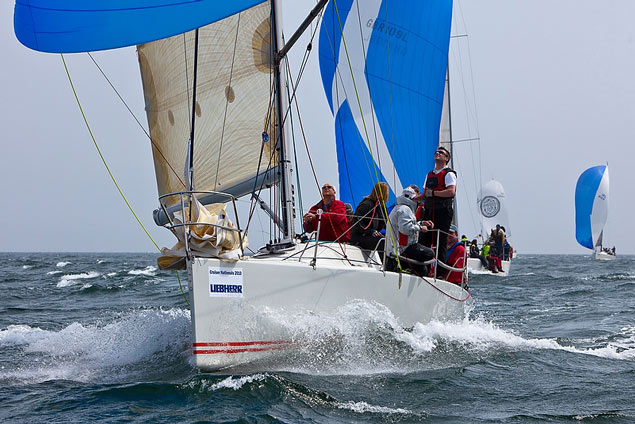 With the Corby 33 Rockabill V, Paul O’Higgins had many successful years. She is seen here racing at the ICRA Nationals 2013 at Tralee Bay. Photo: Robert Bateman
With the Corby 33 Rockabill V, Paul O’Higgins had many successful years. She is seen here racing at the ICRA Nationals 2013 at Tralee Bay. Photo: Robert Bateman
Rockabill V, the Corby 33, became a familiar sight on the circuit, always noted for putting in an interesting and often podium-gaining position, yet almost invariably guaranteed to appear at Calves Week, that amalgam of West Cork Regattas out of Schull early in August, a fun event with an underlying level of quite serious racing which fitted well with the Higgins’ family’s regular summer holidays in West Cork in August.
For a busy man ashore, his commitment to getting afloat as much as possible was remarkable, and his willingness to take part each year in an interesting series of regattas and events saw his crew panel increasing. If you were as keen as Paul O’Higgins, then as a committed panel-member you were going to get sailing. And with first places recorded in various series which ranged from Scotland to Kerry, plus regular participation in Dublin Bay where he sails from the Royal Irish YC, Rockabill V made frequent and regular appearances in the frame.
But by 2014 he began to feel that he’d gone about as far as he could with the Corby 33. She’s a very interesting boat, unforgiving in some ways yet rewarding in others. But nobody would call her luxurious, let alone comfortable. That said, Rockabill V was still winning races. But when a new boat called the JPK 10.80 appeared from a specialist yard in France in the Spring of 2014, his interest was piqued by the fact that she had race potential, yet with her considerable beam, twin rudders, and roomy and comfortable accommodation, was about as different as possible in concept from the Corby.
If he was going to make a change, why not make a complete one? The J/109 seemed an attractive idea, but when the class finally started to take off in Dublin Bay, she was no longer being built. This “new” Dublin Bay One-Design was a class made up entirely of pre-owned boats. Yet Paul O’Higgins had become accustomed to buying from new. Second-hand just wasn’t his thing.
He looked again at the JPK 10.80, and when one of the very first turned up from France to race Cork Week 2014, he was very taken with her despite the fact that in straight sailing, the crew clearly weren’t getting the best from her, while their confusion with Cork Harbour courses compounded their problems.
Paul O’Higgins bided his time until July 2015 when, despite the pressure from the J/109 lobby, he placed an order for a JPK 10.80. It was a decision soon supported by events, with a JPK 10.80 winning the Rolex Fastnet overall in August 2015, and then in December a JPK 10.80 cruising the Pacific was briefly taken out of her cruising reverie, kitted out with racing sails by Gery Trentesaux’s Fastnet-winning crew, and promptly went out and won her class in the Sydney-Hobart Race.
Yet perhaps the best thing of all about having placed his order back in July was that it entitled him to visit the new factory near Lorient where the boat was being built. He went there a number of times, finding it an inspiring place of exceptional cleanliness and precision, while the dedication of designer Jacques Valer and company founder Jean Pierre Kelbert set the tone.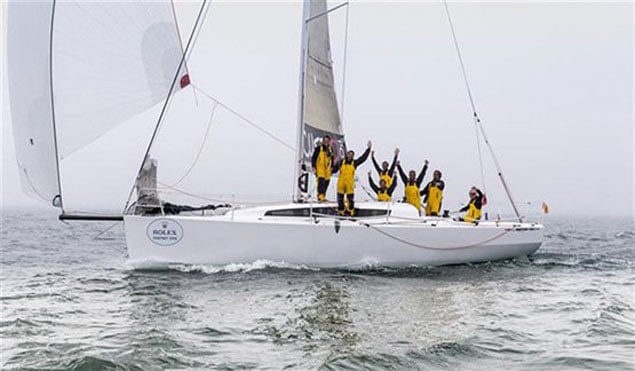 The JPK 10.80 Courier du Leon winning the Fastnet race a month after the order had been placed for Rockabill VI
The JPK 10.80 Courier du Leon winning the Fastnet race a month after the order had been placed for Rockabill VI
Thus although the situation is that an order placed today for a new JPK 10.80 would mean delivery no earlier than the very end of 2018, they are not enthusiastic about taking on extra staff to speed up production. They feel that not everyone would immediately share the JPK ethos, and the current workforce size and output is probably optimal.
 The JPK 10.80’s beamy hull shape with twin rudders was a whole world away from the narrow deep Corby concept.
The JPK 10.80’s beamy hull shape with twin rudders was a whole world away from the narrow deep Corby concept.
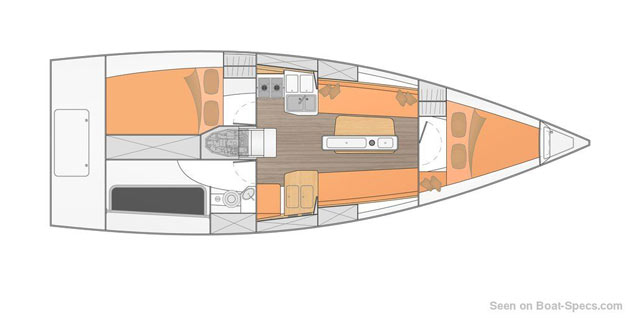 The accommodation is surprisingly roomy and comfortable for a boat which has now added the Dun Laoghaire-Dingle Race win to overall victory in the Fastnet and a class win in the Sydney-Hobart.
The accommodation is surprisingly roomy and comfortable for a boat which has now added the Dun Laoghaire-Dingle Race win to overall victory in the Fastnet and a class win in the Sydney-Hobart.
It may be frustrating for someone who is keen but hasn’t yet made the commitment, but for those already on the ladder or with a JPK 10.80 sailing and winning, it serves to keep the boat’s value very high. You don’t buy a JPK 10.80. You invest in one.
But when Rockabill VI first arrived in Ireland early in the season of 2016, the light airs of her debut event, the ICRA Nationals at Howth, didn’t suit her initial configuration of small sails planned to fit into the preferred IRC Rating band for the best racing in Dublin Bay.
However, for the Round Ireland Race 2016 later in June, she was at her sparkling best for the fast run up the west coast, and seemed to have a class win in the bag when she hit a localised total calm at Inishtrahull. Rockabill VI and a couple of other boats nearby simply sat there for nearly four hours while the closest competition, the J/109 Euro Car Parks (Dave Cullen), came up from very many miles astern with her own breeze to knock Rockabill off the leader perch. With light airs when beating down the Irish Sea, the under-canvassed JPK 10.80 Rockabill VI failed to re-take the class lead.
So although there were many wins in 2016, particularly when there was a good breeze or lots of high-powered offwind stuff, and preferably both, Rockabill VI was on the money, but through the winter Paul O’Higgins implemented a plan to step up the sail area and take the ratings hit.
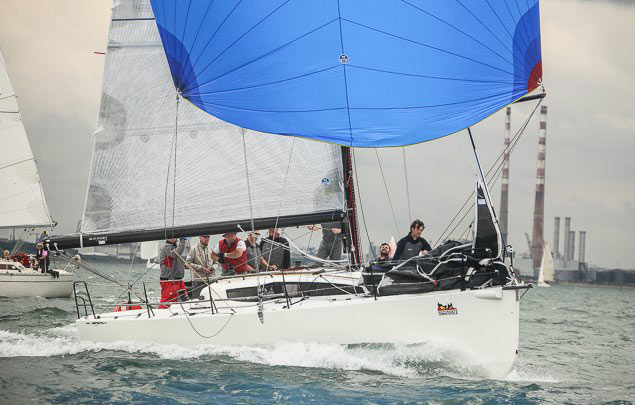 Rockabill VI in the totally familiar surroundings of Dublin Bay Photo: Afloat.ie
Rockabill VI in the totally familiar surroundings of Dublin Bay Photo: Afloat.ie
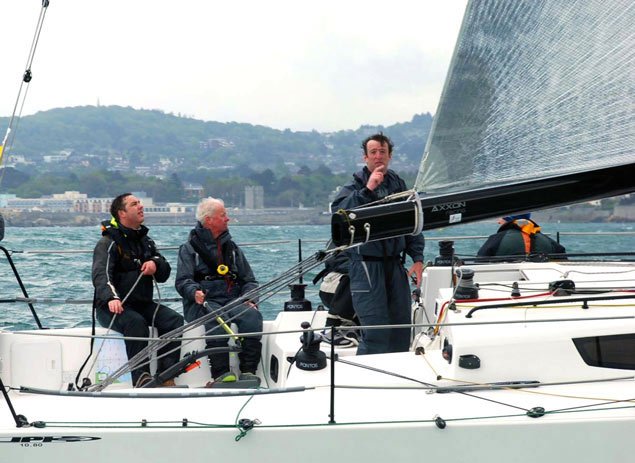 Paul O’Higgins on the tiller as Rockabill VI wins the Holyhead-Dun Laoghaire Race 2017
Paul O’Higgins on the tiller as Rockabill VI wins the Holyhead-Dun Laoghaire Race 2017
Most observers are confident that it will pay ultimately pay off, yet oddly enough there has only been one major race this year in which its success was clearly demonstrated. The Holyhead-Dun Laoghaire – which she won – was a freed-sheet breezy sprint, while the Dun Laoghaire-Arklow was a calm-bedevilled flukerama. So the only true test was the hybrid ISORA Howth-Lambay-Poolbeg race on June 3rd, in which the ISORA fleet sailed Howth YC’s Lambay Race in a gesture to Howth Regatta, but then continued on through the finish line to finish at the Poolbeg Y&BC line as a gesture to the Dublin Port Riverfest.
Hybrid or not, it demonstrated that Rockabill VI’s new configuration was a race winner, but after that there was little opportunity for any further testing before the National YC’s Volvo Dun Laoghaire-Dingle race got under way at 1900hrs on Wednesday June 14th.
We’ve carried at least a dozen continuing reports on Afloat.ie, so there’s no need here to tell you of the ins and outs of a classic race, but what was it like on Rockabill VI, which so convincingly won?
By this stage in a sailing career which has been going on for nearly 35 years, Paul O’Higgins has a trusted crew panel of between 15 and 20 centred on Dublin or Cork upon whom he can draw, and putting together a campaign team of eight for the Dingle Race neatly drew the balance between who was available, who was really keen, and those whose abilities would best complement the core squad which was emerging.
Topping the list was Paul himself and his son Conor, while regular helmsman Mark Pettit was also in from the start. The other main helm became Peter Wilson, whose skills on the tiller or wheel are legendary, and he also brought the kudos of having been a key member of the crew with which Richard Burrows won the very first Dingle Race in 1993 with the Sigma 36 Black Pepper.
Central to the crew was Ian O’Meara of Viking Marine in Dun Laoghaire, who in addition to knowledge of equipment and considerable sailing skills, is married to Jacquie Marsh who heads that very special catering setup, The Butler’s Pantry. Rockabill VI raced with a balanced selection of pre-prepared meals from The Butler’s Pantry, and when feeding time came around, they feasted like kings in the remarkable comfort which this very exceptional boat is able to provide.
Through his contacts on the Dun Laoghaire waterfront, Ian O’Meara had introduced a recent recruit to the crew panel, Will Byrne who was Captain of UCD Sailing in recent years when they’ve been winning every which way. He has also logged offshore racing experience with the RORC programme in the English Channel each summer, and he brought youth and extra skills to the crew for Dingle.
 Will Byrne (right) with his new shipmates at the Fastnet. He was a highly successful Captain of UCD sailing and a veteran of RORC events, but had not sailed the Dingle race before. Photo: Paul O’Higgins
Will Byrne (right) with his new shipmates at the Fastnet. He was a highly successful Captain of UCD sailing and a veteran of RORC events, but had not sailed the Dingle race before. Photo: Paul O’Higgins
Two frequent crew regulars on Rockabill – Rees Kavanagh who knows his way round many boats, and Ian Heffernan who is a professional maritime instructor, made up the total of eight. They were divided into a rolling system of pairing which means that at any one time, there’s always a minimum of four on deck, but proper off-watch spells are guaranteed, as Rockabill VI is laid out in such a way that three people can be fully off-watch and sleeping, yet they’re right up against the weather side of the boat.
This may sound self-indulgent for people who expect to spend a night on the weather rail, but it was part of the formula which contributed to Rockabill’s success. As Paul O’Higgins puts it:
“You really do get a proper little spell of sleep. To begin with, the boat is so well built there is no water finding its way below. Troublesome drips from above are unknown. You won’t find the sleeping bag is slowly dampening from some hidden little puddle. And within the limits of slugging to windward off Ireland’s south coast, she’s as sea-kindly as can be, particularly when you have helmsmen of world quality who know that a banging boat is a slow boat.
But always, there’s the reassurance of knowing how well she is built. She’s definitely not going to fall asunder under you and about you. There’s no better recipe for a refreshing sleep when it’s your turn to be off watch”.
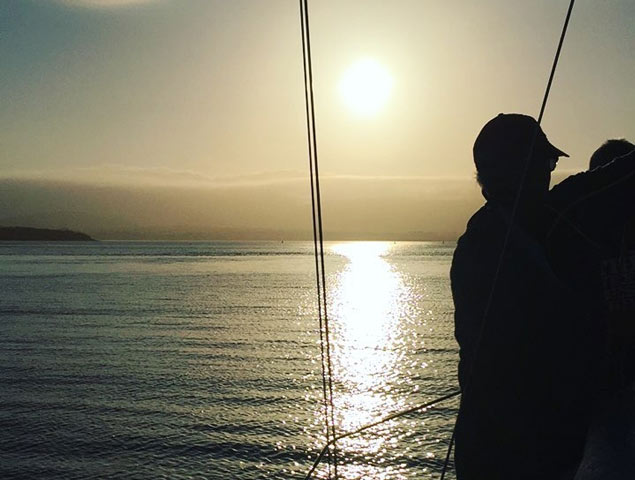 Perfect end to a great race. Summer evening as seen from Rockabill VI heading into Dingle. Photo: Will Byrne
Perfect end to a great race. Summer evening as seen from Rockabill VI heading into Dingle. Photo: Will Byrne
Thus Rockabill VI’s inbuilt advantage over the opposition simply increased as the race went on. Others were giving it best and retired as the going got tough and stayed tough, but on Rockabill, they were on top of it - and enjoying it too.
That said, with the increased rating, they knew that they were vulnerable to any unexpected calm and the constant challenge of the three chasing J/109s, to all of whom they gave quite a bit of time. It was an itch to be scratched .The owner-skipper at his navigation and tactics took to referring to the nearest one, Peter Dunlop & Vicky Cox’s Mojito, as Mosquito.....
Yet most of the time, Rockabill was stretching her lead on Mosquito. When she got to the Fastnet towards 1000 hrs on the Friday morning, they’d lengthened it to eleven miles. A celebratory crew photo with the rock in the background was assembled by Will Byrne, but helmsman Mark Pettit, a very serious person, thought such frivolity was premature.
Evidently the Fastnet Rock agreed with him. It served up a slack patch and a very lumpy sea, and for an agonising period their speed dropped to 3.8 knots. But they got clear of its clutches, and the notorious flat at Mizen Head only slowed them back to 4.4 knots for a while.
And then they were gone, piling on the knots in a warm southwesterly which became stronger the nearer they got to the finish. They came past Skellig Michael at 8.8 knots. The last nine miles into Dingle were seen off in less than fifty minutes. They’d won everything by a country mile and then some. After the finish, they were lined up for photos. History was made. Mark Pettit smiled.
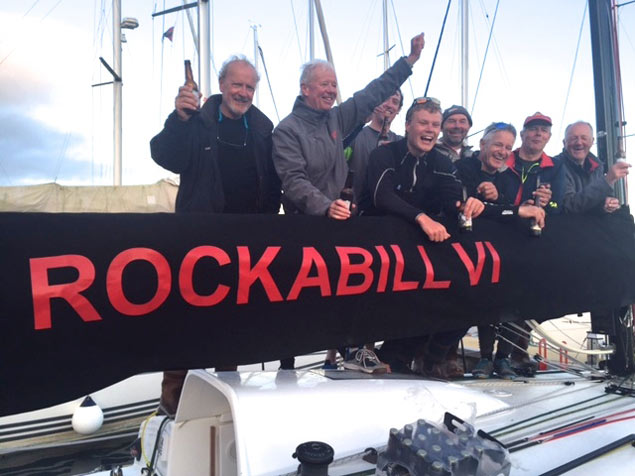 History is made. Mark Pettit (right) is recorded as smiling (well, sort of) at the crew-lineup in Dingle. Others in the photo are (left to right) Peter Wilson, Paul O’Higgins, Will Byrne, Conor O’Higgins, Ian Heffernan, Rees Kavanagh and Ian O’Meara. Photo: Con Murphy
History is made. Mark Pettit (right) is recorded as smiling (well, sort of) at the crew-lineup in Dingle. Others in the photo are (left to right) Peter Wilson, Paul O’Higgins, Will Byrne, Conor O’Higgins, Ian Heffernan, Rees Kavanagh and Ian O’Meara. Photo: Con Murphy
The plans for the rest of the season are very conservative, for this is first and last a Corinthian boat. As a busy lawyer, Paul O’Higgins’ free time is constrained, and he reckons something like a Fastnet campaign is simply too demanding of time, money and other resources when the energy would give a better return deployed in other ways, and his family have always had other ways of being near the Fastnet Rock during August.
So Rockabill VI will return to Dun Laoghaire for DBSC racing, the Volvo Dun Laoghaire Regatta preceded by ISORA’s Lyver trophy Race, some other ISORA events, and then full-on participation in Calves Week out of Schull as part of a family holiday in West Cork, when the boat’s excellent cruising potential will also be utilised.
It’s Irish sailing at its best. This is how it should be done. Topped off with the Dingle Race win before midsummer was even upon us, it’s a very attractive balance.
Read our 2017 Dun Laoghaire–Dingle Race Reports in one handy link here




























